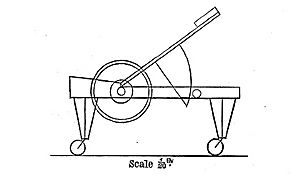Wentworth Erck facts for kids
Quick facts for kids
Wentworth Erck
FRAS
|
|
|---|---|
| Born | July 27, 1827 Dublin, Ireland
|
| Died | January 15, 1890 (aged 62) Sherrington, Shankill, Dublin
|
| Nationality | Irish |
| Education | Rugby School Trinity College Dublin |
| Known for | Studying binary stars and the Sun |
| Scientific career | |
| Fields | astronomy |
Wentworth Erck (born July 27, 1827, died January 15, 1890) was an Irish astronomer. He was also a magistrate and helped people in need. He is best known for studying the Sun's surface and binary stars. These are star systems with two stars orbiting each other. He was also a Fellow of the Royal Astronomical Society.
Contents
Early Life and Learning
Wentworth Erck was born in Dublin, Ireland. His parents were Caroline Minchin and John Caillard Erck. He was the oldest of four children. His first name, Wentworth, came from his grandmother. His father was an important official in Ireland.
Wentworth went to Rugby School for a time. He then studied at Trinity College, Dublin, and finished in 1850. He also became a lawyer that same year. In 1859, he earned his doctorate in law. Even with all his studies, he always loved science, especially astronomy.
In 1870, he married Charlotte Anne Kingston. They made their home in Sherrington, Shankill, Dublin. This was close to Bray in County Wicklow. He was involved in his local church and even built an observatory at his home.
Exploring the Stars: Erck's Astronomy Work
Wentworth Erck spent a lot of time observing the sky. His main telescope was 19 centimeters (7.5 inches) wide. It was made by a famous American astronomer named Alvan Clark. Later, he got a bigger telescope, 38 centimeters (15 inches) wide. He even had a small 9-centimeter (3.5-inch) telescope he took with him when he traveled. This way, he could keep observing the stars.
Studying the Sun and Stars
From 1869 to 1888, Erck carefully watched the Sun. He drew and wrote notes about sunspots almost every clear day. His observations became more accurate as his equipment improved.
He also spent a lot of time studying binary stars. He made nearly 2,000 measurements of these star pairs. He focused on their positions, not their distances. This was because of the limits of his telescope. He also observed the smaller companion stars, or comites, of bright stars like Sirius and Rigel. He even observed Saturn and its moons.
Mars and Jupiter Discoveries
Wentworth Erck was the first person in Ireland or Britain to see the moons of Mars. This was amazing because his telescope was much smaller than the one used by the American astronomer Asaph Hall, who officially discovered them just two weeks earlier. Erck even estimated the size of Mars' outer moon, Deimos.
In 1878, he wrote a paper about the Martian moons. In 1880, he was one of the first astronomers to notice the movement of the Great Red Spot on Jupiter. He also observed and reported on comets, like the Great Comet of 1882.
Sharing His Work
Erck published his findings in newspapers and science journals. These included the Monthly Notices of the Royal Astronomical Society and Nature. He also wrote about his equipment designs. For example, he designed an adjustable chair for observing and a way to keep the eyepiece cool when looking at the Sun. Even though he did a lot of observing, he didn't publish many papers.
Public Service
Besides his astronomy, Wentworth Erck was a dedicated public servant. He worked as a magistrate for County Wicklow. This meant he helped keep law and order. He also served as a poor law guardian, helping people who were struggling. He managed his lands and tenants carefully.
He was a kind and happy person. People respected him greatly. His public duties were very important to him. Some believed that these duties might have affected his health. He passed away at his home in Sherrington.
See also
- List of Irish people


